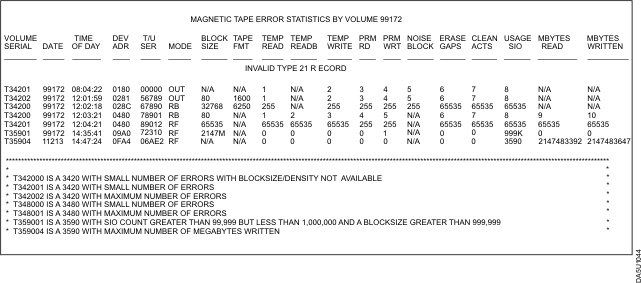 z/OS DFSMSdfp Utilities
z/OS DFSMSdfp Utilities
 z/OS DFSMSdfp Utilities
z/OS DFSMSdfp Utilities
|
Previous topic |
Next topic |
Contents |
Contact z/OS |
Library |
PDF
Input and output z/OS DFSMSdfp Utilities SC23-6864-00 |
|||||||||||||||||||||||||||||||||||||||
|
IFHSTATR uses, as input, ESV records that contain error and usage information about magnetic tape volumes. If no ESV records are found, a message is written to the output data set. If the ESV record is not 62 or 80 bytes long, an INVALID TYPE 21 RECORD message is printed. Run IFASMFDP to convert SYS1.MANX or SYS1.MANY from VSAM to physical sequential prior to using IFHSTATR to retrieve data from the ESV records. IFHSTATR produces an output data set which contains information selected from ESV records. The output takes the form of 121-byte unblocked records, with an American National Standards Institute (ANSI) control character in the first byte of each record. The input data set cannot have a block size that exceeds 32760 bytes. The tapes represented by the SMF records can have block sizes that exceed 32760 bytes. If the block size field or the usage SIO count field in the Type 21 record exceeds 99,999, IFHSTATR scales the output. For example, if the field was greater than 99,999 but less than 1,000,000 it will be scaled to multiples of 1,000 and the letter "K" will be appended. If the field is greater than 999,999 it will be scaled to multiples of 1,000,000 and the letter "M" will be appended. Note that in this case the meanings of "K" and "M" differ from the meanings of "K" and "M" in the BLKSIZE value on the DD statement. On the DD statement, they mean multiples of 1024 and 1048576 respectively. Related reading: For information about IFASMFDP, see z/OS MVS System Management Facilities (SMF). Figure 1 shows a sample of printed output from IFHSTATR. The fields in the printed output are explained in the legend that follows. Figure 1. Sample Output from IFHSTATR




|
|||||||||||||||||||||||||||||||||||||||
 Copyright IBM Corporation 1990, 2014 Copyright IBM Corporation 1990, 2014 |